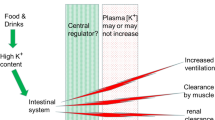Summary
The behavior of potassium and creatine in human muscle during and after work was examined by analysing venous and arterial blood being supplied to the working forearm. Potassium was lost rapidly from muscle during work and returned promptly to muscle in recovery. Creatine was also released from active muscle but its return to muscle ensued far later in recovery. Venous stasis also effected release of potassium from muscle but not of creatine and accelerated the transformation of creatine into creatinine.
Similar content being viewed by others
Literatures
Backman, P., V. Pirilä, T. Raekallio andI. Väänänen: Scan. Arch. f. Physiol.78, 304 (1938).
Fenn W. O.: Physiol. Rev.16, 450 (1936).
Lenn, W. O.: Physiol. Rev.20, 377 (1940).
Keys, A.: Science85, 318 (1937).
Langley, W. D. andM. Evans: J. Biol. Chem.115, 333 (1936).
Osterhout, W. J. V.: J. gen. Physiol.14, 285 (1930).
Wood, E. H., D. A. Collinus andG. K. Moe: Amer. J. Physiol.128, 635 (1940).
Author information
Authors and Affiliations
Additional information
With 5 figures.
Rights and permissions
About this article
Cite this article
Fukuda, T.R. Behavior of potassium and creatine in human muscle during work. Arbeitsphysiologie 14, 425–430 (1951). https://doi.org/10.1007/BF00935409
Received:
Issue Date:
DOI: https://doi.org/10.1007/BF00935409



